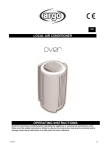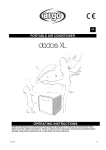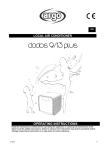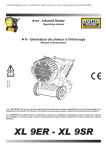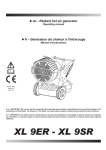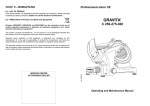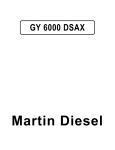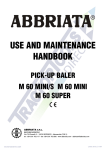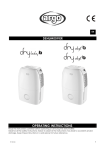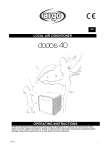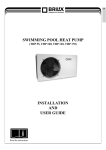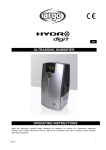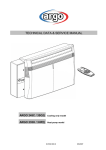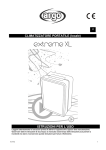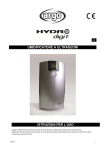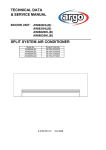Download OPERATING INSTRUCTIONS
Transcript
EN LOCAL AIR CONDITIONER OPERATING INSTRUCTIONS Read the instructions carefully before operating the appliance or carrying out maintenance work. Observe all the safety instructions; failure to observe the instructions may lead to accidents and/or damage. Keep these instructions in a safe place for future reference. V 12/13 12 GENERAL OPERATING AND SAFETY INSTRUCTIONS This appliance is a portable air-conditioner, designed for domestic use. Only use this air-conditioner as described in this manual. Ensure that the required voltage and frequency (220-240V/50Hz) match the available power supply. Ensure that the electricity system is able to deliver the operating current needed by the air-conditioner in addition to that normally absorbed by other appliances (electrical appliances, lighting, etc.). Please refer to the maximum absorption data given on the air-conditioner data plate. Connection to the electricity supply must take place in accordance with current installation standards. Ensure that the automatic switches and system protection valves are able to withstand a start-up current of 7A (normally for less than 1 second). The impedance value of the power supply must be less than 0.219 Ohm. The system socket must always be grounded. Make sure the plug is inserted properly. Do not use multiple sockets. Do not touch the plug with wet hands. Make sure the plug is clean. Do not use the plug to start/stop the air-conditioner: use the power button on the remote control or on the control panel. Do not install the air-conditioner in rooms that may be subject to water sprays (e.g. laundries). This appliance is not suitable for people (including children) with reduced physical, sensory or mental abilities, unless they are adequately supervised by a person responsible for their safety. Before moving or cleaning, ensure that the device is unplugged from the socket. Do not move the air-conditioner while it is operating; first turn the appliance off, check and remove any condensation that may have formed. To turn the appliance off, set the remote control to OFF and remove the plug from the socket. Only pull on the plug. Do not pull the cord. Do not use the appliance if the cord or plug are damaged. If the power supply cord is damaged, it must be replaced by the service centre in order to avoid any safety risks. PRECAUTION! Do not insert any objects into the air-conditioner: this is very dangerous as the fan turns very quickly. Ensure that air circulates freely around the unit. Do not cover the air intake and delivery grilles with drapes or in any way. WARNING! The air-conditioner must be positioned at least 50 cm from the wall and any other obstacles, on a firm, flat surface to avoid water leaks. The air-conditioner is fitted with a system to protect the compressor from overload. This means that the compressor only starts once 3.5 minutes have passed from its previous stop. (When you switch the conditioner on, the fan is working, but the compressor will turn on after the LED HEATING or COOLING flashes 3,5 minutes. This helps prevent the compressor from being damaged). WARNING! In the event of an anomaly, switch the appliance off and unplug from the socket. Do not dismantle or attempt to repair or modify the product. In the event of a malfunction, contact the after-sales service centre directly. WARNING! Do not expose the air-conditioner to direct sunlight, as the colour of the materials may change and if the appliance overheats this may activate the protection mechanism, causing it to switch off. Do not use insecticides, oils, detergents or spray paints near the appliance; do not use aggressive chemical detergents to clean the casing: this may damage the finish and colour. Close all open windows to maximise air-conditioning efficiency. The manufacturer will not be held liable if safety and accident prevention rules are not observed. V 12/13 13 INSTRUCTIONS TO REMOVE THE PACKAGING 1. Place the unit in the correct upright position before unpacking. 2. Cut the two packing straps. 3. Slide the carton upwards and it will release the base. 4. Grip the carry handles located on either sides of the unit and carefully lift it until it slides out of the foam base. 5. Lift and lean the unit slightly to take out exhaust hose from unit’s bottom as in the picture. 6. Install the exhaust hose on the unit before operating the unit. DESCRIPTION OF THE APPLIANCE FRONT VIEW - SIDE FOR COOLING, DEHUMIDIFYING MODES (12) REAR VIEW - SIDE FOR HEATING MODE 1) CONTROL PANEL - FUNCTION BUTTONS FOR OPERATION WITHOUT REMOTE CONTROL 2) REMOTE CONTROL RECEIVER 3) COOL AIR OUTLET (COOLING OPERATION) 4) CONNECTOR FOR COLD AIR EXPULSION HOSE (HEATING OPERATION) 5) TERMINAL CONNECTOR FOR FLEXIBLE HOSE 6) AIR EXPULSION TUBE 7) SIDE GRILL 8) CONDENSATE DRAIN HOLE (COOLING AND HEATING OPERATION) 9) REMOTE CONTROL COMPARTMENT 10) CONNECTOR FOR HOT AIR EXPULSION HOSE (COOLING AND HEATING OPERATION) 11) HOT AIR OUTLET (HEATING OPERATION) 12) AIR FILTERS 13) SIDE GRILLES 14) CONDENSATE DRAIN HOLE (DEHUMIDIFICATION) 15) CONCEALED WHEELS 16) REMOTE CONTROL Operation limits: min/max. (indoor temperature): Cooling: 17°C D.B. - 13°C W.B./ 32°C D.B. – 23° W.B. Heating: 10°C D.B./32 °C D.B. Dehumidify: 10°C D.B./32°C D.B. The heating efficiency will fall off when the outdoor temperature is very low. If enough heating is not obtained with this air conditioner, use another heating appliance in conjunction with it. V 12/13 (16) 14 APPLIANCE START-UP Elements supplied (illustrated in the box below). Remote control. Type CR2025 battery for the remote control. Connector for cold air expulsion hose (heating operation). Connector for hot air expulsion hose (cooling operation). Terminal circular connector to be positioned between the end of the hose and the flat connection for cool/hot air expulsion. Flexible hose. Flat connector for the expulsion of cool/hot air, to be positioned between the circular connection and the window leafs. Position the product vertically on a firm, flat surface, as close to a window as possible, keeping a minimum distance of 50 cm from walls or other nearby obstacles. USE IN COOLING MODE REAR VIEW Insert the connector for hot air expulsion tube on the appliance (1). Turn the flexible hose clockwise - follow the arrow (2) and fix it on the unit . Connect the circular connector to the flexible hose, extend the flexible hose as necessary in order to reach outdoor ( maximum 400 mm); complete with the terminal flat connector, if necessary. In order to remove the flexible hose, turn it counter-clockwise, following the arrow (3). USE IN HEATING MODE REAR VIEW Insert the connector for cool air expulsion on the appliance (1). Turn the flexible hose clockwise - follow the arrow (2) and fix it on the unit. Connect the circular connector to the flexible hose, extend the flexible hose as necessary in order to reach outdoor (maximum 400 mm); complete with the terminal flat connection, if necessary. In order to remove the flexible hose, turn it counter-clockwise, following the arrow (3). V 11/13 15 TRANSITION FROM COOLING MODE TO HEATING MODE REAR VIEW Disconnect the flexible hose and the connector, rotate 180° the unit. Insert the connector for cold air expulsion and the flexible hose on the rear of the appliance. USE WITH TERMINAL CONNECTION FOR WINDOW Connect the end part of the flexible hose (5) to the flat connector (4). Open the windows and block one of the two leafs with the handle. Rest the terminal connection on the fixed leaf, bring the other leaf of the window close. Avoid tight curves and folds in the flexible hose. Connect the power cord to a suitable electrical socket (220-240V). HOW TO USE THE APPLIANCE This appliance can be used to Cool, Dehumidify and Heat. In changing from one mode to another, the fan continues to operate but the compressor stops; the compressor starts up again 3 and a half minutes later. This delay in start-up protects the compressor from any damages. IMPORTANT! For Cooling and Dehumidifying mode, please position the air-conditioner with the control panel and the widest air outlet fitted with deflector in front of you and set Cooling or Dehumidifying mode by the FUNC key the remote control (see chapter OPERATING MODES). on the control panel or To operate in Heating mode, the appliance must be rotated 180º so as to have control panel upside down and the smallest air outlet fitted with deflector in front of you. Then set Heating mode by the FUNC key remote control (see chapter OPERATING MODES). V 11/13 on the control panel or the 16 Cooling Heating Dehumidification THE DISCHARGE TUBE MUST BE CONNECTED to the appliance AT ALL TIMES: the only exception is when the appliance is used for Dehumidification only, in which case it is recommended that the appliance discharges directly into the environment to obtain maximum efficiency (see the paragraph entitled "Dehumidification Mode"). Clean the air filters under the easily removable side panels regularly to keep the air conditioner working efficiently. OPERATING MODES 1. COOLING MODE The first time it is turned on, the air conditioner will operate in Cooling mode with the temperature set to 25ºC by default. The LED COOLING will switch on. The temperature can be adjusted between 17° and 30°C. In this way, each time the Power button is pressed, the unit switches off, the appliance saves the temperature set and when switched back on again, it will retain this setting. In this way, fan speed can be adjusted(button ), Timer can be adjusted and also “SLEEP function”. For a quieter operation set the speed to minimum (LO). 2. DEHUMIDIFICATION MODE Press FUNC to select Dehumidification (DEHUMIDIFY). The LED will switch on. The temperature is controlled by the electronic card and cannot be regulated. In this way, each time the Power button is pressed, the unit switches off, the appliance saves the settings and when switched back on again, it will retain them. In this way it is possible to set the TIMER. Fan speed is fixed to low (LO) and cannot be adjusted. NOTE The air-conditioner does not cool the environment when operating as a dehumidifier. When the appliance is used as a dehumidifier, the flexible hose must not be connected. For maximum dehumidification efficiency, leave the rear discharge attachment free to discharge directly into the environment. Dehumidification mode is recommended in autumn and winter. If used in summer, it is better to leave the flexible hose attached, in order to send the hot air outside rather than releasing it into the environment. During dehumidification, it is better to ensure continuous drainage (see paragraph entitled "HOW TO ELIMINATE CONDENSATION"). V 11/13 17 3. HEATING MODE TO USE THE AIR CONDITIONER IN HEATING MODE, DISINSERT THE FLEXIBLE HOSE AND THE CONNECTOR, ROTATE 180° THE UNIT. INSERT THE CONNECTOR FOR COLD AIR EXPULSION AND THE FLEXIBLE HOSE ON THE REAR OF THE APPLIANCE. Press FUNC to select HEATING. The LED will switch on. By default, the temperature is set to 25ºC. The temperature can be adjusted between 15° and 25°C. In this way, each time the Power button is pressed, the unit switches off, the appliance saves the temperature set and when switched back on again, it will retain this setting. Fan seed is fixed to the maximum (HI) and cannot be adjusted. In this way, Timer and SLEEP functions can be set. HOW TO ELIMINATE CONDENSATE This equipment automatically vaporises the condensation in Cooling and Heating mode. Ensure that when the unit operates as Cooling or Heating, the rubber caps that close the discharge holes on the sides are correctly positioned. When the air conditioner works in Cooling and Heating, there is no need to arrange for continuous drainage of condensate; only in specific weather conditions where air humidity levels are very high may water deposit within the unit. When the internal tank is full, the control panel displays E4, to warn that it is full and the unit stops working. Cooling and heating To empty the tank, switch the air conditioner off and unplug it. Remove the drainage hole cap at the bottom on the right (frontal view, cooling operation) and connect a little tube through which drain the condensate; place the other end on top of a normal reservoir. Ensure that the tube is not twisted or bent. The tube must slope downwards. Close the drain again with the cap and restart using the air conditioner. Dehumidification ATTENTION! When using the air conditioner in Dehumidification mode, we recommend always ensuring continuous drainage, in order to guarantee maximum dehumidification efficiency. To empty the tank, switch the air conditioner off and unplug it. Remove the drainage hole cap below the grill on the right side (rear view) and connect a little tube through which drain the condensate; place the other end on top of a normal reservoir. V 11/13 18 CONTROL PANEL AND REMOTE CONTROL FOR OPTIMAL REMOTE CONTROL FUNCTION, POINT THE HEAD OF THE TRANSMITTER TOWARDS THE RECEIVER ON THE AIR-CONDITIONER. Button TEMPERATURE INCREASE Button TEMPERATURE DECREASE Button TIMER Button SLEEP Button fan speed AUTOMATIC Button FUNC MODE SELECTION Button fan speeds HIGH - MEDIUM - LOW Button POWER - ON/OFF (1) SIGNAL TRANSMITTER (2) ON/OFF BUTTON (POWER ) Press the POWER button to switch the unit on or off. When switched on, the appliance will start to operate as it was last set (memory function). (3) FUNCTION SELECTION BUTTON (FUNC ) Press this button to select the different operating modes, according to the following sequence: Cooling → Heating → Dehumidification (4) (5) TEMPERATURE ADJUSTMENT BUTTON ▲▼ Increase (▲): 1) Enables the adjustment of the temperature desired in Cooling and Heating modes. 2) Each time the (▲) button is pressed, the temperature set increases by 1ºC; by holding the button pressed, the temperature increases continuously. V 11/13 19 Decrease (▼): 1) Enables the adjustment of the temperature desired in Cooling and Heating modes 2) Each time the (▼) button is pressed, the temperature set decreases by 1ºC; by holding the button pressed, the temperature decreases continuously. (6) FUNCTION DISPLAY The display shows the temperature and the set timer. When the temperature and timer are set, the new temperature will be displayed for a few seconds, then the display shows again the room temperature. This display detects also errors: Problem E1 – E2 E4 Cause Defective temperature sensor or PCB. Tank full or plug not correctly fitted. Solution Contact the service centre. Empty the tank. Check that the plug is fitted correctly into the socket. Then press POWER button . (7) SPEED BUTTON Press this button when the appliance is on in order to set the fan speed in cooling mode. High fan speed: the LED HI will switch on Medium fan speed: the LED MID will switch on Low fan speed: the LED LO will switch on When the LED AUTO switches on the air conditioner regulates automatically the fan speeds on the 3 possible levels. On the remote control there are three buttons: high speed medium speed low speed. In heating mode the speed is automatically settled at the maximum value and in dehumidification mode at the minimum value. (8) TIMER OFF BUTTON (AUTOMATIC SHUTDOWN) Press this button when the appliance in order to set the time remaining before the unit is switched off can be set: • • Select a number of hours from "1" to "24". Press the TIMER button consecutively and the number of hours increases by 1 each time it is pressed, up to 24. • Press the Power button before the time expires and the setting will be cancelled and unit will switch off. (9) SLEEP BUTTON 1) By pressing the button once, the unit enters “sleep” mode and the indicator on the control panel lights up; by pressing the button a second time, the unit leaves sleep mode and the indicators turns off. 2) When activating the SLEEP function in Cooling mode, the temperature set increases automatically by 1ºC every hour for the next 2 hours: it then remains stable for the rest of the time. 3) When activating the SLEEP function in Heating mode, the temperature set decreases automatically by 1ºC every hour for the next 2 hours: it then remains stable for the rest of the time. 4) Each time the air conditioner is switched off, SLEEP mode is cancelled. To restore, simply press the SLEEP button once. REMOTE CONTROL BATTERY Insert the battery into the remote control, respecting polarities specified. Only use type CR2025 batteries 3 V Li, in accordance with European Directive 2006/66/EC (supplied with the remote control). Remove the battery if the remote control is not used for a month or longer. Do not attempt to recharge the battery. Do not throw the battery onto a fire, it may explode. V 11/13 20 HOW TO INSERT / REMOVE THE REMOTE CONTROL BATTERIES (refer to the diagram below) Open the battery cover at the rear of the remote control (press and pull the cover). Place the battery into the cover, observing the correct polarity. Insert the cover on to the remote control. INFORMATION FOR CORRECT DISPOSAL OF THE PRODUCT IN ACCORDANCE WITH EUROPEAN DIRECTIVE 2006/66/EC Please replace batteries when flat: at the end of their useful life, batteries must not be disposed of with unsorted waste. It must be must be delivered to appropriate separated waste disposal plants or to dealers that provide a similar service. Separate waste disposal of batteries prevents potential negative effects on the environment and human health resulting from inadequate disposal, and also allows the materials from which it is made to be recovered and recycled in order to achieve significant savings in terms of energy and resources. The separate disposal obligation is underlined by the crossed-out dustbin symbol appearing on the battery. Illegal disposal of the product by the user shall result in the application of administrative sanctions as defined by current regulations. CARE AND MAINTENANCE WARNING! Before carrying out any cleaning or maintenance, unplug from the electric socket. 1. Cleaning the air filters The air filters must be checked at least once every two weeks of use. Operating with dirty or blocked filters will decrease the effectiveness of the air-conditioner and can cause serious problems. To remove the filters, release the two upper sides of the side grilles and pull them delicately upwards. Use a vacuum cleaner to remove dust. If this should not sufficient, wash the filters with warm water and a neutral detergent if necessary. Rinse with cold water and leave to air dry before replacing. Once the two filters have been replaced, close the grilles once again and return to use the air-conditioner. 2. Cleaning the casing. Use a damp and soft cloth to clean the exterior surface of the air-conditioner. Do not use water that is too hot, solvents, petrol or other aggressive chemical compounds, talcum powder or brushes: these may damage the surface or colour of the casing. To remove stains use warm water with a little neutral detergent. Do not pour water onto the air-conditioner to clean it: this may damage the internal components or cause a short circuit. 3. Storage. When you do not envisage using the air-conditioner for a long time, before storing it away, clean the filters. Keep the appliance in a vertical position at all times. Do not rest heavy objects on the top and, if possible, protect the air-conditioner with a sheet of plastic. V 11/13 21 4. Transport. If possible, transport the air-conditioner in a vertical position. If not possible, lie it on its right side; when you reach your destination, immediately return the appliance to a vertical position and wait at least 4 hours before using it. 5. For complete safety, regularly check the condition of the power cord; if it should be damaged through use, to replace it contact the Service Centre. ADVICE FOR MAXIMUM COMFORT AND MINIMUM CONSUMPTION CHECK that: the unit suction and delivery grilles are always free; the air filters are always clean; a dirty filter will decrease the passage of air and reduce the unit performance; doors and windows are closed, to avoid the infiltration of unconditioned air; the flexible hose is correctly positioned, without sharp bends or curves. F-GAS REGULATION (EC) no. 842/2006 Do not release R410A into the atmosphere: R410A is a fluorinated greenhouse gas covered by the Kyoto protocol, with a global warming potential (GWP) of 1975. INFORMATION FOR THE CORRECT DISPOSAL OF THE PRODUCT IN ACCORDANCE WITH EUROPEAN DIRECTIVE 2002/96/EC When this appliance reaches the end of its useful life, it must not be disposed of with household waste. It must be delivered to appropriate separated waste disposal plants or to dealers that provide a similar service. Separate waste disposal of an electrical appliance prevents potential negative effects on the environment and human health resulting from inadequate disposal, and also allows the materials from which it is made to be recovered and recycled in order to achieve significant savings in terms of energy and resources. The separate disposal obligation is underlined by the crossed-out dustbin symbol appearing on the product. Illegal disposal of the product by the user shall result in the application of administrative sanctions as defined by current regulations. www.argoclima.com V 11/13 22











